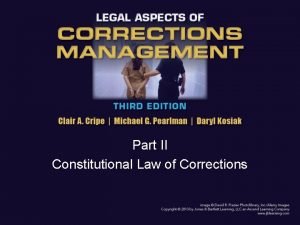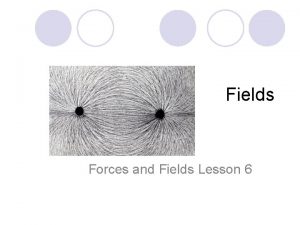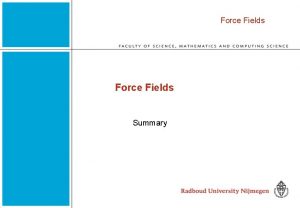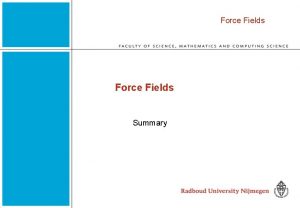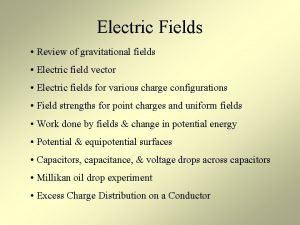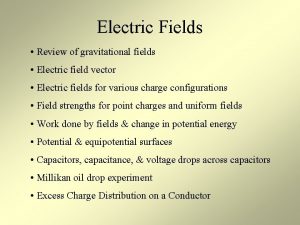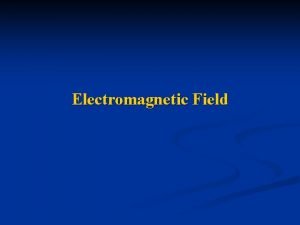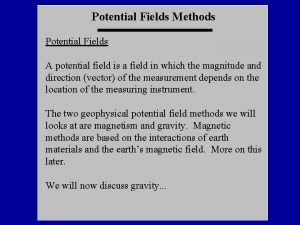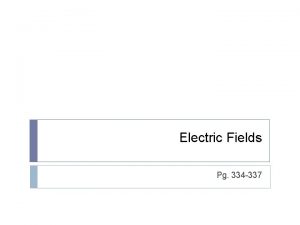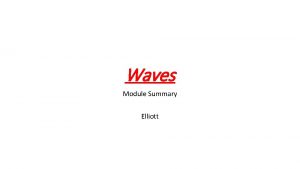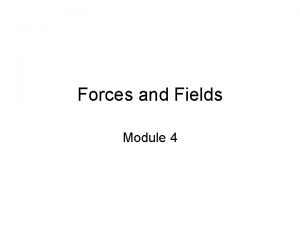Fields Module Summary Elliott Field lines Field lines























- Slides: 23

Fields Module Summary Elliott

Field lines • Field lines are drawn to represent the flux of a field. • The lines represent force acting in the direction of the arrows. • The more densely packed the lines, the stronger the force at that point. • In electric force fields the force considered is that on a positive test particle. • N. B. flux lines never cross.

The inverse square law •

Gravitational fields •

Electric fields •

Comparing electrostatic with gravitational • You can see that there are clearly some similarities between Coulomb’s and Newton’s laws. Gravitational force Electrostatic force Obeys inverse square law Force between masses Force between charges Is always attractive Can be repulsive or attractive Constant of proportionality G is found empirically and is universal Relatively weak except over large distances Generally cancels out over large distances but otherwise stronger than gravitation

Force fields • The properties of both gravitational fields and electric fields can be derived from the two previous laws.

Worked example •

Uniform electric field • Angle θ

Electric flux and Gauss’ law •

Magnetic fields • The force of magnetism also creates force fields, most typically imagined as the distribution of iron filings around a bar magnet. • Magnetic fields are closely related to the electric field. • Because we therefore have to envisage them in three dimensions, the following conventions are used. Notice the similarity between a feathered arrow entering and leaving the page

Permittivity and permeability • Similar to the permittivity of an electric field, the magnetic field has a permeability which determines how well the field penetrates a substance. • Permittivity ε is measured in farads per metre. • Permeability μ is measured in henrys per metre – it is the amount energy stored (or released) from a magnetic field.

Ampere’s law •

Biot-Savart law •

Magnetic field strength •

Magnetic force from a wire •

Force between conductors •

Comparing magnetic and electrical fields • We can look at some of the contrasting properties of magnetic electrical fields. Electric field Magnetic field Electromotive force (EMF) in V Magnetomotive force (MMF) in NI Electric field strength in V m-1 Magnetic field strength in H Current, I Flux, Φ Current density, I A-1 Flux density, B

Force on a charged particle •

Magnetic force on an electron •

Magnetic flux •

Induction • Any change in magnetic flux through wire will induce an EMF. You may think of it as the field line “cutting” the wire.

Faraday’s law •
 Red fields to green fields
Red fields to green fields Learning: module 26: magnetic forces and fields
Learning: module 26: magnetic forces and fields In flanders fields summary
In flanders fields summary Amelia a. erwitt
Amelia a. erwitt Yrdsb career cruising
Yrdsb career cruising Dana elliott
Dana elliott Pierre elliott trudeau high school courses
Pierre elliott trudeau high school courses Pierre trudeau high school
Pierre trudeau high school Elliott richelson
Elliott richelson Michael elliott md
Michael elliott md Dr suzanne elliott
Dr suzanne elliott Pierre elliott trudeau high school courses
Pierre elliott trudeau high school courses Elliott lancaster
Elliott lancaster Elliott durham school
Elliott durham school Kathryn elliott
Kathryn elliott Elliott business software
Elliott business software Sandy elliott
Sandy elliott Digital solutions bolton
Digital solutions bolton Joseph elliott actor
Joseph elliott actor Elliott cheu
Elliott cheu Pargo v elliott
Pargo v elliott Jodi levine laufgraben
Jodi levine laufgraben Timo elliott sap
Timo elliott sap Clark elliott depaul
Clark elliott depaul




















